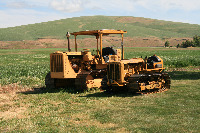- Posts: 10
- Thank you received: 0

ACMOC Membership Benefits
- FREE quarterly magazine filled with content about antique Caterpillar machines
- FREE classified listings
- ACMOC store discounts and specials
- Full Bulletin Board Access
- Marketplace (For Sale/Wanted)
- Technical Library
- Post attachments
$44 /year ELECTRONIC
$60 /year USA
$77 /year International
- Forum
- Antique Caterpillar Machinery Owners Club
- DISCUSSION
- Who would have imagined Holt would build this
Who would have imagined Holt would build this
During WW1, Holt (later Caterpillar) built a number of experimental armoured vehicles. Arguably the strangest was
the Holt Steam Wheeled Tank. It was a tank, with armour plate a couple of MGs and a 75mm howitzer. It had
big wheels rather than tracks - the wheels came from another Holt ag. machine and were about 5 foot diameter.
Just to add to the confusion it was powered by a Doble steam system with each wheel being driven independently.
There's very little information on the tank. It was tested by the Ordnance Dept at Aberdeen in March 1918 and proved
to be quite agile. The Steam Wheel Tank was retained at Aberdeen until after WW2 when it seems to have been scrapped.
The image is the only one I've seen of the Steam Wheel tank. The tank possibly looked like the model image - this is a cardmodel
in 1/25 scale.
landships.info/landships/tank_articles.h...am_Wheeled_Tank.html
Regards,
Charlie
Please Log in or Create an account to join the conversation.
- old-iron-habit
-

- Offline
- Platinum Boarder
- Member
- Posts: 3631
- Thank you received: 16
Please Log in or Create an account to join the conversation.
Like OIH says, thank you for the info
9U(2), 5J, IHC544, Ford860
Please Log in or Create an account to join the conversation.
Cat 12 grader, 8T6995 running and restoring, Cat 12 grader 9K3585. parts machine, Adams leaning wheel Pull grader Mod # 22, ser#438
Please Log in or Create an account to join the conversation.
There is a tank at Columbus New Mexico. It is in a museum that has the history of Pershing trying to chase down Pancho Villa in Mexico after Pancho invaded the USA at Columbus NM. I say try, because Pancho was on horse back an Pershing was fully mechanized. This was prior to WW1. It was a good lesson on logistics which aided us during WW1. Anyway back to the tank. I think it was made by Holt and was a track vehicle. Gasoline powered and gas mileage was 2 gallons to the mile. See the logistics problem? No gasoline in Mexico at that time. Pershing chased Villa 450 miles and gave up.
Logistics and a mechanization have never mixed well. In WWI a lot of stuff was hauled to the front with horses so that gas and lubricants were available for what few vehicles and aircraft they had. In WWII, North Africa, both the British and Germans were halted at times because of the lack of fuel and supplies. Then once the Allies broke out of Normandy they had an extremely difficult time keeping supplies flowing to the fast moving armies until they secured ports further north as the low countries were liberated.
Very interesting tank. There were a lot of design concepts for armor vehicles around that time. We, the US, copied/used the French and British tanks of the day because of our late entry to the war. Interestingly when the 1st US expeditionary force arrived in France, commanded by Gen Black Jack Pershing both the French and Brits wanted to break them up and feed the US soldiers and Marines into their lines as replacements. Pershing refused saying they would fight as an American unit of not fight at all.
WWI was a shambles because the old generals refused to modify tactics to suit the new weapons of the day, mostly the repeating bolt action rifle and the machine gun. Those 2 items did away with facing each other in a line abreast formation and dictated the fire and maneuver tactics used in WWII and still today. The generals were the ones responsible for the slaughter.
Thanks for posting that!
Rick
Please Log in or Create an account to join the conversation.
Please Log in or Create an account to join the conversation.
Thanks Charlie for sharing that picture.
Pat
Pat in WI
Please Log in or Create an account to join the conversation.
Rick, you may want to read the article below ("Diggers and Doughboys"), written by a historian at the Australian War Memorial.Interestingly when the 1st US expeditionary force arrived in France, commanded by Gen Black Jack Pershing both the French and Brits wanted to break them up and feed the US soldiers and Marines into their lines as replacements. Pershing refused saying they would fight as an American unit or not fight at all.
Your quote as regards Pershing withdrawing all his troops to fight as stand-alone American units, is only partly true.
Remember, General Pershing and his Doughboys arrived at the WW1 front in 1918, as "green" and untested "rookies". The British, the French and the Australians were already 4-year war veterans, and skilled in the ways of the Germans.
It was believed by the British (who were in charge of the running of the War) that letting American units loose to fight on their own, would only result in a lot of unnecessary troop losses, due to front-line inexperience.
This view was also held by General Pershing - and the agreement between General Pershing and the British C-in-C, Field Marshal Douglas Haig, was that the newly-arrived Doughboys would be kept as defensive units, in the case of an emergency (such as a German breakthrough).
However, the Australian Commander, General Sir John Monash, wanted to "embed" (cute word, isn't it?) the American troops in with his Australian troops, for a major attack he had planned on the village of Hamel.
Monash planned to get the Australian Diggers to teach the Doughboys the hard-earnt infantry tactics and strategies that they had learnt, so the Doughboys would know how to attack the Germans, and also be wised up to their tricks (of which they had plenty!).
As a result, the British agreed, and 10 companies of Doughboys were placed (embedded) in with the Australians, to carry out Monash's carefully-planned attack on Hamel.
When Gen. Pershing arrived at the front and found the 10 companies of Doughboys in the front line with the Australians (and under the command of Australians), he protested to Haig that the arrangement was not what had been agreed upon - and Pershing promptly withdrew 6 of the Doughboy companies.
However, Pershing eventually left 4 Doughboy companies embedded in with the Australians, as Monash had argued it would be of benefit to the Doughboys to "learn the ropes" - and Monash really needed as many men as he could get.
The 6 American Doughboy companies withdrawn, were replaced by Australian Diggers.
The disagreements between Pershing and Haig were basically rooted in the underlying disdain of the British by the Americans - many of whom, still carried memories of throwing the British out of the American colonies - and they were happy to regularly remind the British of that fact!
The battle of Hamel commenced on cue, and it was a textbook attack and totally successful. Monash had allocated 90 mins to reach their target successfully and capture it - and it was done in exactly 93 minutes.
The Doughboys were admired for their pluckiness by the Australians, but also regarded as too "gung-ho" - they took too many unnecessary risks, according to the Australian Diggers.
The American troops rapidly picked up tactics and strategies, and their efforts were greatly appreciated by both British and Australian troops, even if their appearance was a little late in the war.
The Doughboys were good capable fighters - however, there was much more respect between the Diggers and the Doughboys, than there was between the Doughboys and the British.
The Aussies were unhappy with the British running of the War, and in particular the poor British military leadership. The Aussies demanded Monash as their Commander, rather than British Commanders, and the British agreed.
General Monash was revered by the Aussie troops, and he was a cut above any British military leader. Monash was the first to understand and develop the technique of blending air support with troops on the ground, with artillery and tanks.
Monash went on to win nearly every campaign he led - that was more than 50 attacks on the Germans. It was said later that if Monash had been handed a Commanders position earlier in the War, the War would have ended 2 years earlier.
Monash was noted for his concern for his troops well-being, and was deeply affected by any losses of his men. It was believed this worry and concern shortened his life.
AFAIC, General Monash was one of the worlds greatest military leaders. When he died in 1931 at the age of 66, 300,000 Australians attended his funeral. Strangely enough, Monash was born into a German Jewish family!
"Diggers" and "Doughboys" - the Americans and Australians at Hamel, 1918
Biography - Sir John Monash
Sorry to get a little sidetracked from Antique Caterpillars - but I just wanted to ensure the record was straight - it was the Aussies who taught the Americans front-line fight tactics!
Lots of great WW1 photos below, of the Americans in WW1. The Australian War Memorial hold the worlds biggest collection of war memorabilia.
Americans in WW1
Regards, Ron.
Please Log in or Create an account to join the conversation.
- Forum
- Antique Caterpillar Machinery Owners Club
- DISCUSSION
- Who would have imagined Holt would build this
ACMOC
Antique Caterpillar Machinery Owners Club
1115 Madison St NE # 1117
Salem, OR 97301
support@acmoc.org
"I became a member recently because the wealth of knowledge here is priceless."
- Chris R
"I also joined a year ago. had been on here a couple of times as a non-member and found the info very helpful so I got a one year subscription (not very expensive at all) to try it out. I really like all the resources on here so I just got a three year. I think its a very small price for what you can get out of this site."
- Jason N


